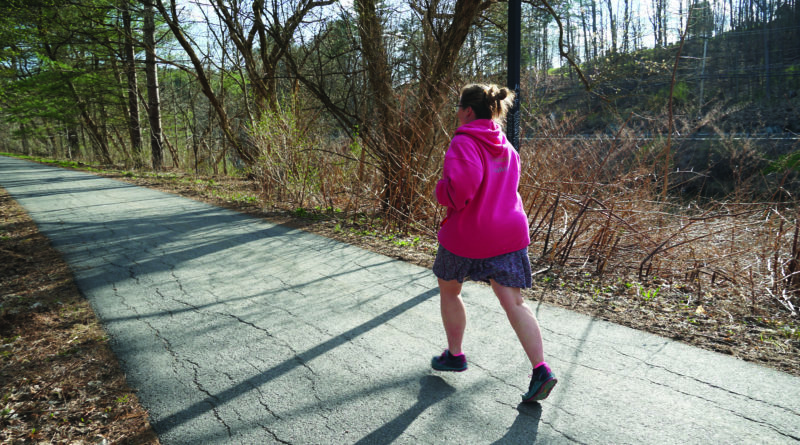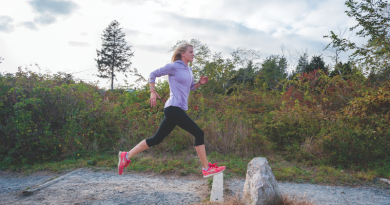Run Without Injuries
By Sarah Richardson
Running had been a part of my regular routine for 20 years until I tripped in a pothole in during an adventure race in 2008 and injured my ankle. Being injured was a new experience. Each time I tried to start running again, my body would not let me go more than two miles without pain. This was my first serious injury. It sidelined me for four years and sent my world into a tailspin.
Running is just a thing I do to feel good. I’m not competitive, I’m not fast, but I love how it feels when I’m running consistently. So, what happens when a life-long runner goes from running marathons to not being able to run two miles? Depression. Anxiety. A 50-pound weight gain. My physical and mental health took a steep nosedive. The decline felt scary and frustrating. I needed a solution. I scoured bookshelves and the Internet and there it was: ChiRunning.
ChiRunning is a specific technique for running that integrates the movement principles of T’ai Chi, such as body sensing, alignment and relaxation, and focuses on gradual progress.
The two major themes throughout ChiRunning are energy efficiency and injury prevention. These are accomplished through proper form (body mechanics), and running position. This allows a runner to not only utilize the force of gravity, but also neutralize the force of the oncoming road. Rather than meeting a force with a force—as overstriding and heel striking do—the legs swing to the rear with ease, eliminating impact, all while gravity assists in pulling you forward in a controlled fall.
ChiRunning, I read, had helped thousands of runners improve their form, reduce and prevent injuries, and decrease recovery time. Runners of all ages and levels could improve their efficiency and performance. It was as applicable to a newbie runner just getting started as to an avid runner looking to become more efficient. And it was especially helfpul for a runner looking to solve chronic injuries.
And chronic injuries were what I was facing. I searched for a local clinic and that brought me to ChiRunning’s co-founder, Danny Dreyer, in Boston.
The Principles of ChiRunning
Twenty years ago, Danny Dreyer and his wife Katherine developed the ChiRunning technique. Danny, faced with some running issues of his own, dove deeper into his T’ai Chi practice and began studying distance runners. The movement principles of T’ai Chi helped to heal his body, and the data he gathered from his studies confirmed that mindful movement, alignment, relaxation, and using the pull of gravity while cooperating with the force of the oncoming road were the keys to efficient running and preventing injuries.
His clinic followed the ChiRunning formula: the running was intentionally designed to help runners of all types access proper form. The day was filled with fun exercises and drills, such as the pull-down exercise, body looseners, pool running and knee bending. Our body sensing improved as Danny talked us through what our tripods (the three points in your foot that hit the ground) felt like, what being relaxed versus engaged felt like in our shoulders and legs, and how to find and move from our center. The goal, Dreyer said, was for each runner to know the difference between conventional running and ChiRunning and to feel the difference in their body.
Eight lessons introduced the overall concepts: the physics of running and the keys to effortless, injury-free running; proper posture; leading with your center; ChiWalking (which is a low-impact form of walking and emphasizes good biomechanics including good posture, loose joints, an engaged core and relaxation of the arms and legs; arm swing); stride length and gears; cadence and then putting it all together.
Each lesson built upon the former and focused on maintaining proper alignment of the body’s column, because the more aligned you are through your column, the more you relax your extremities. The idea is to shift the workload out of the legs and into the core and bring ease and flow to the legs where most running injuries occur. Additional topics discussed during the day included hills, training plans, core strengthening, sneakers and motivation.
That first clinic in Boston changed everything for me. I was shown how my ankle injury had changed my alignment. My left foot splayed out significantly, my stance had widened and my stride elongated—all in compensation for my injury. As I continued to compensate, it led to other misalignments and more pain in other places. Once I realigned, and listened to my body, the relief was instant. If my left foot hurt, I adjusted my tripod so my foot fell evenly. If my hamstring felt pain, I shortened my stride. If my hips ached, I leveled my pelvis using my core. I was able to problem solve while running, and that felt wonderful.
Training a New Generation To Run
Over the years, the Dreyers have trained and certified hundreds of instructors all over the world. In 2014, I became one of them. The process for certification was both rigorous and rewarding. I had to be able to model the techniques consistently and correctly as well as effectively teach the movement principles so that students could feel the difference between conventional running and ChiRunning.
Then last year, the Dreyers announced their retirement from ChiLiving. In an effort to preserve their life’s work, four other master instructors and I purchased the company. It was important to us to maintain the integrity of the curriculum and continue to share it with our local communities.
I now teach ChiRunning and my favorite part is to begin and end the clinic with a personalized video analysis that shows each runner how they came into the clinic, and any changes they made during the clinic. It is rewarding to see the “a-ha” moments as a runner sees what they can do to become more efficient or solve a discomfort.
One client in particular struggled with chronic injuries her whole life, believing pain, injury, and even surgery, was part of being an athlete and distance runner. Over the last two years, she fully implemented the principles of ChiRunning. She not only has remained free of injury during this time but has learned a new way to communicate with her body.
ChiRunning is not a quick fix, as lasting change rarely is. But I’ve learned how to feel good in my body as it is, and feel proud of the incremental accomplishments. It shifted my relationship with running. It helped me to reconnect with my body and turned running into personal practice, a mindful meditation.
Sarah Richardson is the author of From Sidelines to Start Lines: The Frustrated Runner’s Guide to Lacing Up for a Lifetime is a master ChiRunning instructor, owner and coach. She teaches ChiRunning clinics in Barre, VT and throughout New England. She also hosts ChiRunning and ChiWalking retreats on Lake Champlain, and provides ongoing coaching services a


